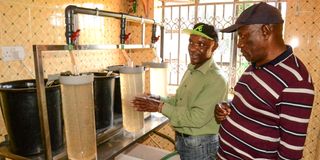Engineer goes for gold in ornamental fish

Stanley Kaguongo (right) and his farm manager Daniel Njoroge on their Nyahururu Aqua Fish Farm in Laikipia.
What you need to know:
- With over 13 indoor and open-air ponds and a hatchery, Stanley Kaguongo rears pricey ornamental fish that he sells to those seeking to beautify their homes and offices
- Kaguongo, who gets his customers through referrals and also markets his products on social media, ensures frogs don’t thrive in his open ponds by harvesting and transferring them into the ponds with catfish.
- For better growth, one needs to check the weight of the fish and the pH and temperature of the water regularly.
- Nyandarua county director of fisheries Joshua Bosire says fish farming requires little space, is environmentally friendly and offers good returns if one does things right.
Standing on the edge of a concrete pond, Stanley Kaguongo watches contentedly as the colourful fish dart in water, making beautiful patterns.
He keeps an eye on one of the fish, which appears bigger than the others, then asks his manager, Daniel Njoroge, to transfer it to the next pond.
The farmer, who keeps the fish on his 12-acre Nyahururu Aqua Fish Farm in Ol’Jabet, Laikipia County, has specialised in the ornamental varieties though he also keeps catfish and tilapia.
Some of the fish is kept in open ponds and others inside greenhouses or aquariums.
“I am a structural engineer and run my firm in Nairobi, but I love fish farming, in particular ornamental fish,” says Kaguongo, who started the business in 2013.
On the farm, he keeps red, silver, gold and yellow comet, subnkin, lionhead, carico and blackmore ornamental fish.
Specific hormones
Kaguongo also runs a hatchery for tilapia. The unit is a small room where the eggs harvested from a female fish are fertilised manually using sperms collected from a male tilapia.
“We do this so that we are able to end up with mono-sex fish. Fries (young fish) have no sex thus by giving them feeds with specific hormones, you are able to end up with fish of a sex you want,” Kaguongo explains, noting male fish is the most preferred because they grow bigger thus weigh more kilos in a shorter time.
From the hatchery, the tilapia fries are fed for about 21 days inside ponds in the greenhouse before being taken to open air ponds where they are sold as fingerlings with each going for Sh12.
Some of them are raised to maturity when they are sold in kilos at Sh400 each. A kilo of catfish, on the other hand, goes for Sh350.
Inside the greenhouse standing on an eighth-acre are 13 stone-walled ponds, about half stocked with 4,000 ornamental fingerlings each. The other ponds host tilapia and catfish.
“Watching fish darting in water is therapeutic that is why people love to keep ornamental fish in aquariums in their homes,” Kaguongo says, dispelling the notion that the fish is a preserve of the affluent.
Pet shop owners
Pet shop owners particularly in Nairobi and Mombasa are the biggest wholesale buyers of the fish from his farm. The fish is sold from four months, with an inch going from Sh40 to Sh50.
But blackmore, fantails and long fin kois are sold a piece from Sh400 to Sh2,500 depending on size, says Kaguongo, who has invested in the business Sh7 million.
Eggs laid by ornamental fish in the open ponds are collected and incubated in the greenhouse ponds where they hatch under controlled temperatures and water quality.
“After 21 days, the fingerlings are released back into the open ponds,” Njoroge offers.

Workers harvest tilapia and ornamental fish at Nyahururu Aqua Fish Farm in Oljabet, Laikipia County.
For better growth, one needs to check the weight of the fish and the pH and temperature of the water regularly.
“Too much or too low acidity in the pond water is dangerous for fish. The ideal pH is between 7 and 8. This is the reason we avoid tapping water from the nearby Melwa River that cuts across the farm because it is polluted. Instead, we use stream water,” says Njoroge.
Major challenges
Predators like otters and birds are some of their major challenges. They have managed to keep them off by fencing off the open ponds using wire mesh and covering them using nets.
“When I started fish farming, I bought fingerlings from Sagana Fish Farm, put them in ponds and went away. I came back after a year hoping to harvest big but ended up with stunted fish.
I went back to Sagana blaming them for having sold me bad fingerlings,” says Kaguongo, adding he was advised what to do right.
Kaguongo, who gets his customers through referrals and also markets his products on social media, ensures frogs don’t thrive in his open ponds by harvesting and transferring them into the ponds with catfish.
“Catfish is carnivorous and feeds on the young frogs, that is how we ensure the population is kept low,” says the farmer, who feeds his fish commercial rations.
Nyandarua county director of fisheries Joshua Bosire says fish farming requires little space, is environmentally friendly and offers good returns if one does things right.
He notes one should not mix ornamental fish with tilapia or catfish in one pond for quality control.
Less sensitive
A major disease one has to guard against is fin rot. It is common in pond fish and attacks the fins of a fish.
Affected fish has frayed fins and the skin is dull or bloodstained.
The disease is as a result of weak body condition of fish permitting the bacteria Pseudomonas.
For ornamental fish, koi and goldfish are the most affected. However, tilapia and catfish are not much hit by the disease because they are less sensitive.
To curb the disease, give fish good quality feeds to reduce the risk of attack.
Maintain high standard of hygiene in ponds and do not crowd fish in a pond.




